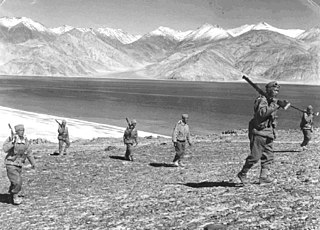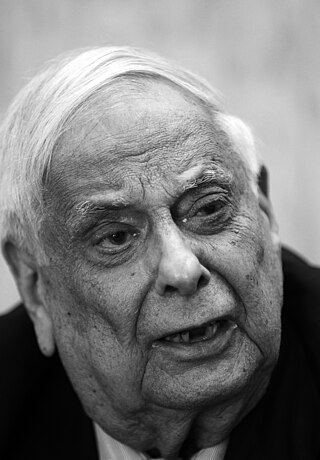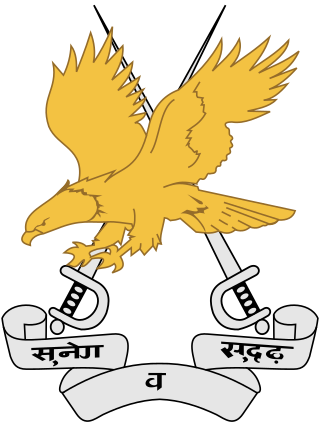Related Research Articles

The Sino-Indian War, also known as the China–India War or the Indo-China War, was an armed conflict between China and India that took place from October to November 1962. It was a military escalation of the Sino-Indian border dispute. Fighting occurred along India's border with China, in India's North-East Frontier Agency east of Bhutan, and in Aksai Chin west of Nepal.

Aksai Chin is an arid region divided between India and China, mostly controlled by China as part of Hotan County, Hotan Prefecture, Xinjiang and partly in Rutog County, Ngari Prefecture, Tibet and constituting the easternmost portion of the larger Kashmir region that has been the subject of a dispute between India and China since 1959. It is claimed by India as part of its Leh District, Ladakh Union Territory.

The Indian Army is the land-based branch and largest component of the Indian Armed Forces. The President of India is the Supreme Commander of the Indian Army, and its professional head is the Chief of Army Staff (COAS). The Indian Army was established on 1 April 1895 alongside the long established presidency armies of the East India Company, which too were absorbed into it in 1903. Some princely states maintained their own armies which formed the Imperial Service Troops which, along with the Indian Army formed the land component of the Armed Forces of the Crown of India, responsible for the defence of the Indian Empire. The Imperial Service Troops were merged into the Indian Army after independence. The units and regiments of the Indian Army have diverse histories and have participated in several battles and campaigns around the world, earning many battle and theatre honours before and after Independence.

Lieutenant General Jack Farj RafaelJacob was a general officer in the Indian Army. He was best known for the role he played in the Bangladesh Liberation War of 1971. Jacob, then a major general, served as the chief of staff of the Indian Army's Eastern Command. During his 36-year long career in the army, Jacob fought in World War II and the Indo-Pakistani War of 1965. He later served as the governor of the Indian states of Goa and Punjab.

Jayanto Nath Chaudhuri, was an Indian Army general who served as the 6th Chief of Army Staff from 1962 to 1966 and the Military Governor of Hyderabad State from 1948 to 1949. After his retirement from the Indian Army, he served as the Indian High Commissioner to Canada from 19 July 1966 until August 1969.
Major Navdeep Singh is an author, lawyer and a former reservist-vounteer of the Indian Territorial Army.

The Sino-Indian border dispute is an ongoing territorial dispute over the sovereignty of two relatively large, and several smaller, separated pieces of territory between China and India. The first of the territories, Aksai Chin, is administered by China as part of the Xinjiang Uyghur Autonomous Region and Tibet Autonomous Region and claimed by India as part of the union territory of Ladakh; it is mostly uninhabited high-altitude wasteland in the larger regions of Kashmir and Tibet and is crossed by the Xinjiang-Tibet Highway, but with some significant pasture lands at the margins. The other disputed territory is south of the McMahon Line, in the area formerly known as the North-East Frontier Agency and now called Arunachal Pradesh which is administered by India. The McMahon Line was part of the 1914 Simla Convention signed between British India and Tibet, without China's agreement. China disowns the agreement, stating that Tibet was never independent when it signed the Simla Convention.

General Pran Nath Thapar was the fourth Chief of Army Staff of the Indian Army. The Sino-Indian War was fought during his term, in which the Indian Army fared poorly. Thapar resigned during the last stages of the war, handing charge to Lt. Gen. J. N. Chaudhuri.

Lieutenant General Jagjit Singh Aurora, was an Indian Army General Officer who was the General Officer Commanding-in-Chief (GOC-in-C) Eastern Command during the third war with Pakistan in 1971. He organised and led the ground forces campaign in the Eastern Front of the war, which led to an overwhelming defeat of the combined Pakistan Armed Forces in East-Pakistan that led to the creation of Bangladesh.

The Army Aviation Corps (AAC) is the youngest arm of the Indian Army, being formally designated on 1 November 1986. The Army Aviation Corps units are designated as Squadrons. Each squadron generally consists of two Flights. Reconnaissance (Recce) and Observation flights might be part of squadrons or operate independently. The latter do not have a parent squadron and are designated by an (I) in their name.

Western Command is a Command-level formation of the Indian Army. It was formed in 1920. It was disbanded following its demotion to an independent district and eventual merge with Northern Command to form the North-western Army. It was re-raised in 1947 following the transfer of Northern Command HQ to Pakistan. Until 1972, it was responsible for India's border with Pakistan in the North and West and the Chinese border in the North. The Command HQ is in Chandimandir, Haryana, about 5 km east of Chandigarh.

The Army Training Command, abbreviated as ARTRAC, is one of the seven commands of the Indian Army. It is currently based at Shimla. It was established in 1991.
The Galwan River flows from the disputed Aksai Chin area administered by China to the Union Territory of Ladakh, India. It originates near the caravan campsite Samzungling on the eastern side of the Karakoram range and flows west to join the Shyok River. The point of confluence is 102 km south of Daulat Beg Oldi. Shyok River itself is a tributary of the Indus River, making Galwan a part of the Indus River system.

The Ardagh–Johnson Line is the northeastern boundary of Kashmir drawn by surveyor William Johnson and recommended by John Charles Ardagh as the official boundary of India. It abuts China's Xinjiang and Tibet autonomous regions.

Wing Commander Jag Mohan Nath was an Indian Air Force officer. He was the first of the six officers to have been decorated with the Maha Vir Chakra, India's second highest war time military decoration, twice. He was decorated for his operations in the Sino-Indian War of 1962 and Indo-Pakistani War of 1965.
Tianwendian is the name of a border outpost and a military defence area of China in the northern Aksai Chin region under its administration. The region is roughly equivalent to the portion of Depsang Plains under Chinese control. Its headquarters, the Tianwendian outpost, is in the Chip Chap River valley close to China's Line of Actual Control with India.
Major General Anant Singh Pathania MVC, MC was a decorated Indian Army general; the first Indian to receive a Military Cross in the Second World War, he was also the first Indian commanding officer of the Gorkha Rifles. During the Sino-Indian War of 1962, he commanded the 4th Infantry Division during a critical stage of the conflict where his leadership was criticised.
Heweitan is the location of a Chinese border outpost in the region of Aksai Chin that is controlled by China but disputed by India. According to the Chinese Ministry of National Defense, it is the highest border outpost in the country.
The Chinese order of battle in the 2020–2021 China–India skirmishes.
References
- 1 2 3 4 5 6 7 8 Yadav, Yojana (4 September 2019). "We fight more among ourselves than against enemy, it's time to change: Major General Rajendra Nath (retd)". Hindustan Times. Retrieved 14 February 2021.
- ↑ Bajwa, Mandeep Singh (22 January 2013). "Gen Naths recce in Aksai Chin". Hindustan Times. Retrieved 14 February 2021.
- ↑ Malhotra, Iqbal Chand (17 October 2020). "Why report on Capt Rajendra Nath's 1952 expedition to Aksai Chin is classified to this day". ThePrint. Retrieved 15 February 2021.
- ↑ Praval, Major K.C. (29 March 2011). "1971: Making Bangladesh a reality - II (Book Excerpt: Indian Army After Independence)". Indian Defence Review. Retrieved 14 February 2021.
On 16 December, Major General Ansari and his divisional staff surrendered to Barar at Kamarkhali, while his garrison at Faridpur, more than 3,000-strong, laid down arms before Brigadier Rajendra Nath.
- ↑ Institute for Blind Chandigarh
- ↑ Patial, RC (3 February 2017). "The Lure of the Mountains". Salute. Retrieved 14 February 2021.